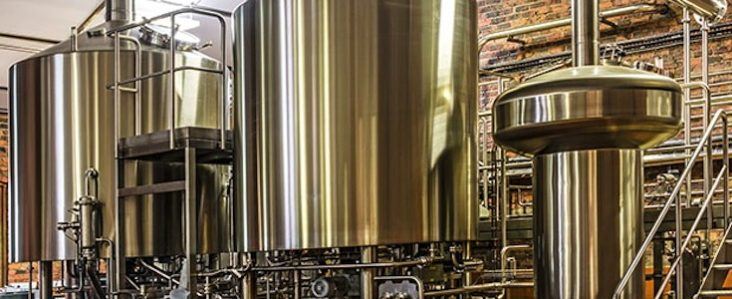Arkansas brewer says craft beer industry growth bolstered by federal tax bill
by December 21, 2017 11:30 am 1,164 views

Arkansas’ craft beer industry doubled in size between 2014 and 2016, but a Northwest Arkansas brewer said there is still room to grow, and that momentum could be helped by a proposed tax cut for brewers within a revised tax code bill passed Wednesday (Dec. 20) by Congress.
There were eight breweries in the state in 2014, and two years later that number increased to 16, according to data from the U.S. Department of Labor’s Bureau of Labor Statistics. The BLS recently published an industry spotlight on craft beer nationwide.
It showed over a 10-year period, from 2006 to 2016, breweries accounted for more than half of growth in the beverage manufacturing industry in the U.S. There were fewer than 500 breweries in the country before 2010, and in 2016 there were 2,843, according to BLS. The 2016 number is more than seven times the number of breweries in 2001, with the biggest jumps in the nationwide brewery count occurring in 2013 and 2014.
Jesse Core, owner of Core Brewing Co. in Springdale, said there is room for more craft beer manufacturers in Arkansas.
“I think we are at our infancy in this state. I think there’s tremendous growth opportunity in this space,” Core said.
Core Brewing Co. was founded in 2010 and its beer is now served in 500 locations, according to its Facebook page. There are now nine Core Brewing Co. pubs and Core said two more will open by the end of January.
There was one brewing company in Arkansas in 2006, according to BLS, so the industry has grown quickly since then, but Core said the pace is starting to slow a bit. He believes the industry will “continue to thrive and grow,” he said. “We’re excited about the increased competition.” The company employs 12 full-time staff and 25 part-time, but Core refrained from sharing how much product the company puts out.
“A group of us are trying to get away from focusing on size and instead really focus on the quality of the beer,” he said.
For that reason, Core and other brewers have stopped reporting their outputs to Brewers Association.
“We’re just all trying to work together to create the best beer culture together.”
Congress recently passed a tax reform bill that includes a provision that would cut the federal excise tax in half for small breweries, and that move will bolster the industry, Core said.
Under the bill, the federal excise tax on beer will be reduced to $3.50 per barrel from $7 per barrel on the first 60,000 barrels for domestic brewers producing less than 2 million barrels annually.
“It’s a great thing for craft beer,” Core said. “With the money we’ll save we can hire another person, and that is what we’ll do. … What I would hope is that our legislators continue to create channels and paths to allow microbreweries to grow and thrive.”
Core Brewing is also in the distillery business, and he said a boost for that industry is “on the heels” of the craft beer movement.
“Microbrewing and distilling do great things for our economy in terms of creating tourism destinations. They are great revenue generators for the state,” in addition to creating jobs.
JOB CREATION
In terms of employment, the BLS data show breweries accounted for more than half of the employment growth within the beverage manufacturing industry in 10 years, while the soft drink and ice sector shrunk. Its share of employment within the industry grew from 15% to 25%.
The largest 12-month employment increases occurred in 2015 and 2016, with growth rates in both years of about 21%, according to BLS. Nationwide, the brewery industry employs 58,580 people, with California and Colorado making up the largest brewery hubs. Indiana had the fastest brewery employment growth over the past decade, with 54 times the number of jobs in 2016 than in 2006, according to BLS.
Arkansas data on brewery employment is not available until 2014, and it showed growth in that two-year period. Employment in breweries was 108 that year, followed by 161 in 2015 and 202 in 2016.
The U.S. soft drink and ice manufacturing category is still the largest employer, with a workforce of 171,601 people nationwide and making up 44% of the beverage manufacturing industry. Wineries make up 26% and distilleries had a share of about 5%.
UPWARD MOMENTUM
The nationwide upward trend in the beer industry doesn’t show signs of stopping. No state saw a decline in breweries over the 10-year period, and only six states had fewer than 10 breweries in 2016.
In 2006, no state had more than 50 breweries, and by 2016 15 states had more than 50, and 10 states have more than 100, according to BLS. The number of brewery establishments increased by 614% during that time, faster than wineries, which grew 112%, but trailing behind the growth pace of distillery establishments, which increase 744%.
In 2006, soft drink and ice manufacturing held the largest share of establishments in the beverage manufacturing industry (45%), followed by wineries (44%), breweries (9%) and distilleries (2%). By 2016, the share held by breweries had grown to 30 percent.
Average weekly wages for breweries were $969, below that of distilleries ($1,362) and soft drink and ice manufacturing ($1,028). Over 10 years, brewery wages decreased by one-quarter, from $1,293 in 2006, according to BLS.
Meanwhile, producer prices for beer and ale in barrels and kegs increased 52% over 10 years. Bottled beer producer prices increased 29%, and canned beer prices increased 28%.
